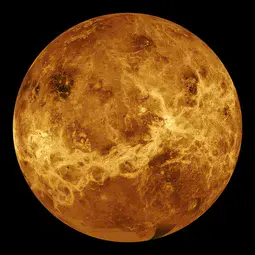How Venus went rogue and what that might mean for Earth
24 May 2022
MUNICH — Venus, Earth’s nearest neighbour and once-potential twin, is a hot mess. Surface temperatures average about 475 degrees Celsius (hot enough to melt lead), it is covered in volcanoes, and it is enshrouded in a toxic atmospheric soup of carbon dioxide and sulfuric acid. The planet is often described as a hellscape. But it wasn’t always this way. In fact, at one time, it may have been habitable. If and how it transitioned from habitable to hothouse are areas of, um, hot debate. But Michael Way of NASA Goddard Institute for Space Studies and Uppsala University and his colleagues have an idea — and it has potential implications for Earth and other Earth-like planets.
Basically, Way says, somewhere between 250 million and 3 billion years ago, Venus’s temperate climate gave way to a runaway greenhouse state. How? Likely massive volcanism worse than the worst ever seen on Earth, he says. Way, Richard Ernst of Carleton University in Canada and Tomsk State University in Russia, and Jeffrey Scargle of NASA Ames Research Center in California, will present their hypothesis and evidence on how Venus went rogue this week during the European Geosciences Union (EGU) General Assembly 2022.
Way, Ernst and Scargle turned to Earth’s history of massive volcanic eruptions — called Large Igneous Provinces or LIPs — for a model. In the last 2.8 billion years, they say 560 enormous fissures have opened up and spewed lava over much of our planet. Some, including the Siberian Traps that erupted 252 million years ago in present-day Siberia, caused mass extinctions (the Permian-Triassic mass extinction that killed some 90% of Earth’s species). Others, like the more-recent Columbia River Basalts in the Pacific Northwest of the United States, just created beautiful scenery (though they were pretty devastating between 16.7 and 5.5 million years ago). Many of these LIPs occurred in close proximity — geologically speaking. Had they been larger or occurred even closer together, with two or three simultaneous events or even stacked up within a few hundred thousand or million years, Earth may have had a very different history, the team says.
When the crust opens up and enormous amounts of lava flow out, greenhouse gases are released into the atmosphere, creating a toxic atmosphere along with strong warming. This can trigger a runaway greenhouse effect, the team notes. Had this occurred on Venus — a distinct possibility, the team says — it could have triggered the so-called “Great Climate Transition” in which a habitable planet becomes quickly inhospitable.
Simulations like this, which show how natural events may have led to a runaway greenhouse on Venus, rendering it the hellscape it is today, reveal how such a runaway greenhouse could occur on Earth should such volcanism occur. Temperatures rise, the atmosphere traps more heat and temperatures rise further, oceans evaporate, trapping more heat … and eventually an Earth turns into a Venus. It does not paint a rosy picture.
“A long-term temperate climate in a terrestrial world like Earth should not be taken for granted,” Way says. “Large-scale volcanism is capable of dramatic climate change and can drive a lovely temperate world like Earth today to something that resembles our hothouse neighbour Venus,” he says. “So we should not be surprised if we find worlds in Earth-like orbits around solar-like stars with Venus-like climates.”
Despite being so hot, Venus is one cool planet to study. Want to learn more about our closest neighbour? Check out the PS4.1 session at EGU 2022 on Wednesday 25 May.
More information
When reporting on this story, please mention the EGU General Assembly 2022, which is taking place from 23-27 May 2022. This paper will be presented in session PS4.1 on Wed, 25 May, 10:54–11:01 CEST. If reporting online, please include a link to the abstract: https://meetingorganizer.copernicus.org/EGU22/EGU22-4357.html. Press release text by Megan Sever.
Contact
Gillian D’Souza
EGU Media and Communications Officer
Munich, Germany
media@egu.eu


